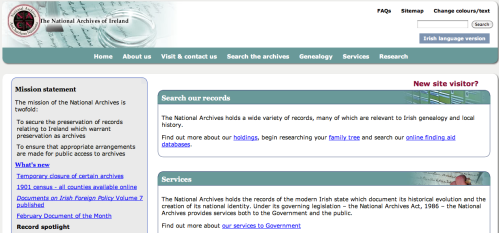02 November 2010
Figure 1: Screen Grab of The Cobh Heritage Centre Website.
After I returned home from my visit to the Cobh Heritage Centre, I decided to explore their website to see what additional information the exhibition had to offer, and to see how the centre advertises itself as a tourist attraction and repository of historical and genealogical information through the digital medium of the web. As can be seen from Figure 1, the website’s design is simple, but its minimalistic appearance makes site navigation easy. Having designed websites for academic projects and with my knowledge of hypertext mark-up language, it is apparent to me that a lot of work went into the construction and maintenance of this website.
Although the website doesn’t contain the factual and historical information of the exhibition, which is financially logical considering that the purpose of the website is to attract national and international customers, it does provide services that cannot be achieved outside of the digital realm.
The ‘E-Wall of Dedications’ is a prime example of the advantages of embracing digital technology. This feature allows users to honour their Irish immigrant ancestors who passed through Queenstown Cobh enroute to the New World, by displaying their name on the E-Wall.
Figure 2: Screen Grab of E-Wall of Dedication. Cobh Heritage Centre Website.
It is evident from Figure 2 that substantial amounts of people have avialed of this unique feature in order to express a sentimental gesture of heart felt, kindness and respect for their deceased progenitors. The act of writing one’s name on a wall may appear to some as a glorified form of graffitti but in fact its implications are significant. Visitors to the site may recognise the names and thus assist them in locating their ancestry.
However, what I found to be most pertinent about the E-Wall is that it amalgamates both the public and private, personal and communal space. The E-Wall is a private space dedicated to one’s ancestry but it is open to public view. Therefore, the list of names are not merely a collection of letters and words with no significance to those unrelated to the subjects. Eventhough these names are unknow to me they carry a greater weight of meaning than an Irish Immigrant memorial plaque, because it has been personalised by the respective authors.
The Cobh Heritage centre website also contains a comprehensive list of resources that are hyperlinked.
Figure 3: Screen Grab of Cobh Heritage Centre Website.
It is evident from Figure 3, one of the resources listed is The National Archive of Ireland . This archive contains the records of the Irish State that record the evolution of Irish history and the development of Irish national identity. Their mission statement is to preserve records that merit preservation and to make these archives accessible to the public. Therefore, the research potential of this archive is enormous because of its primary source material and its online, open-source accesibilty. There is no subscription fee or log-on required to search the online database. Figure 4 shows that this website also has a specific section for genealogy and information on how to carry out an accurate search of records to find one’s family tree.
Figure 4: Screen Grab of The National Archive of Ireland.
Another resource listed on the Cobh Heritage centre website is The Addergoole Titanic Society. As the title suggests, the purpose of this website is to document the Titanic-Mayo connection.
Figure 5: Screen Grab of the Addergool Titanic Society Website.
Out of the one hundred and thirteen, third class passengers who boarded the Titanic in Queenstown Cobh, 14 of them came from Addergoole parish, Co. Mayo. 11 of those 14 passengers died, but 3 passengers survived the tragic sinking of the Titanic. According to the website, the eleven passengers from Addergoole that died “represent 0.3% of [their local] population”. This not only offers one an alternative perspective of immigration and the tragedy of the Titanic from a perspective external to Queenstown, but it also demonstrates the impact immigration had on the small rural areas of the West of Ireland. A loss of this proportion to a small nit community would have been emotionally devastating but also financially debilitating, as their families main source of income was removed. The families involved probably invested a lot of hard earned money in financing their sons or daughters transport expenses, which would have been repaid by the money earned and sent home from America.
The Cobh Heritage centre website adds an additional bonus to the experience of the exhibition. Although it does not offer much additional information, it does provide resources that have assisted my search for genealogy and knowledge. Consequently, the boarder of the Cobh Heritage centre introductory webpage is decorated with the emblem of a jigsaw piece, which in my opinion is poignant because its website is the final piece that completes the picture of Irish emigration portrayed by the exhibition.




















